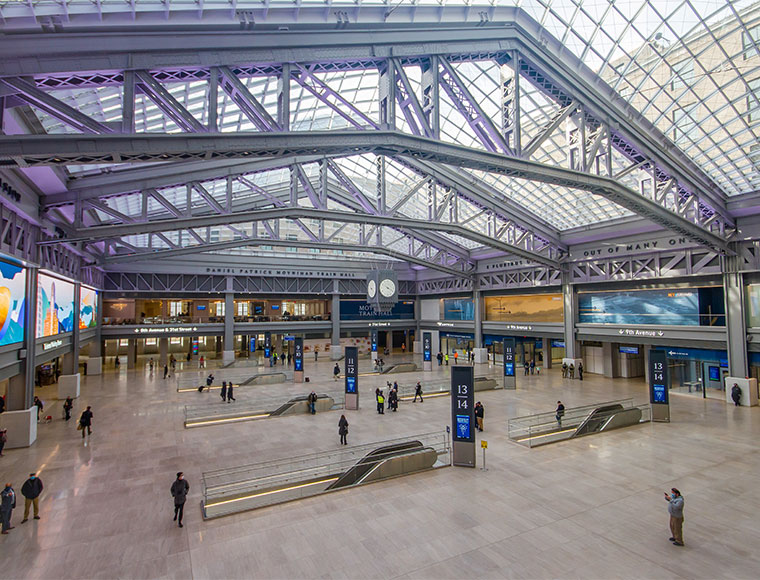“We travel every day across bridges and through tunnels and along subway tracks that were built in difficult times, because other generations invested in us. Moynihan Train Hall is a symbol of our will to do the same thing today, because investing in the future is actually one of the best ways we have to keep afloat in the present.”
— architecture critic/Moynihan Train Hall adviser Paul Goldberger at the opening of the hall, Jan. 1, 2021
“Creating something for people is like a new start, a fresh start. It’s something to look forward to.”
— Ralph R. Mackin Jr., Mackin Architects PLLC (Page 28)
When the Daniel Patrick Moynihan Train Hall opened in Manhattan on New Year’s Day, it did more than provide Amtrak and Long Island Rail Road passengers with greater access to most of Pennsylvania Station’s 21 tracks. Named for the late New York senator who championed humanistic urban renewal and the project, the 486,000-square-foot, $1.6 billion complex restored the James A. Farley Building — New York City’s former main post office, now home to the hall — while conjuring the ghost of another Beaux Arts-style gem by McKim, Mead & White, the original Penn Station, whose neoclassical glory met the wrecking ball in 1963.
In the ensuing decades, as the idea of historic restoration has taken hold, New Yorkers have become kinds of design-minded Adams and Eves, in search of an architectural paradise lost. Critics have praised the new train hall as a thing of glasshouse beauty embracing a central atrium, retail space, a 320-seat waiting area, restrooms and artwork in a structure that recalls the soaring, girded, lucent old Penn, while noting that it does nothing to resolve the subterranean problems of the current Penn, slithering beneath Madison Square Garden.
Still, with the Moynihan Train Hall, New Yorkers have gotten something of their own back at a time when they were laid low, even if the very thing that laid them low, the coronavirus, has prevented the usual throngs from enjoying it. It’s the irony of a great deal of design, isn’t it? Created by an individual or group in an uncertain present, often to reimagine a long-gone past for an unknown future. Yet it’s what we humans do.
We build onion-domed, gracefully scalloped monuments to the dead — like the Taj Mahal, Indian emperor Shah Jahan’s tribute to wife Mumtaz Mahal — knowing someday we, too, will die and it will be left for others to love them.
We seek to recapture the past or at least preserve the remains of its day, like Iraqi archaeologists in Babylon, trying to hold off time and developers at a replica of the ancient city’s fabled, cobalt-tiled Ishtar Gate.
We strive to heal what has been ravaged, making it whole in ways that are perhaps better but certainly are also different (the new World Trade Center). In this we are much like Hana in “The English Patient,” who shores up the staircase of a bombed-out monastery where she is caring for the critically burned patient of the title in World War II Italy as much for her own soul as for him.
Indeed, such is our hunger to create and recreate that we do it against all odds. Sometimes we do so unwittingly, for everyone’s past is someone else’s present and future, just like everyone’s present and future will be someone else’s past.
No one could’ve foreseen the pandemic when now-struggling Hudson Yards or the Moynihan Train Hall were in the planning stages. The Chrysler Building was topped and plans for the Empire State Building were underway just as the stock market crashed in October of 1929. Neither would be fully occupied for decades. But that didn’t stop the investors, the architects, the builders, the workers and the visitors from going all in.
We should take comfort in that. The structures now standing half-empty in New York City will find new life or at least their sites will, and those who gave so much to realize them will see their work remembered if not themselves. Even now how many know that the Moynihan Train Hall’s project manager, Michael Evans, took his own life 10 months before completion of the work he so painstakingly oversaw? Still, it is his Taj Mahal, with mementoes of his life, including his hard hat and work boots, sealed into one of the hall’s columns.
But his real legacy are those visitors and future generations, who in running for a train or sitting in the waiting room or buying a gift or cup of coffee, will marvel at the space and bless him without even knowing his name.
Rescuing Syria, brick by brick
On April 13, Thames & Hudson will publish “Building for Hope: Towards an Architecture of Belonging” by Syrian architect Marwa al-Sabouni (“The Battle for Home”), a compelling, new exploration of how cities and buildings — scarred by conflict, blight and pandemic — can be healed through design and urban mindfulness.
“The Battle for Home,” chronicling how her city of Homs, Syria was undone by decades of architectural mismanagement, brought al-Sabouni to the attention of international media and institutions. In “Building for Hope,’ she draws from personal observations of Western cities, lessons from Islamic culture and a range of thinkers to explore how cities and buildings might be rebuilt in the aftermath of conflict, crisis or financial depression — and create lasting peace in a polarized world.
— Edited by Georgette Gouveia






